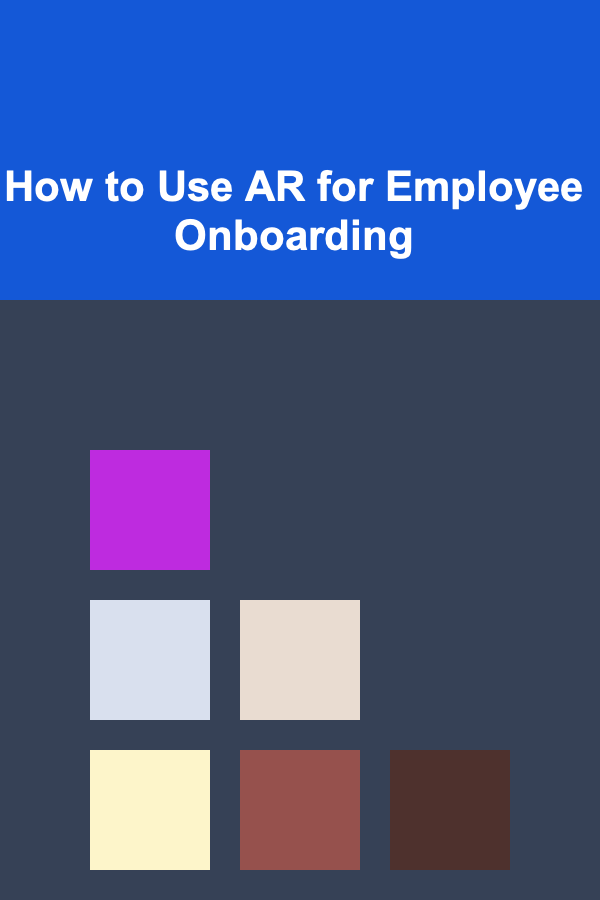
How to Use AR for Employee Onboarding
ebook include PDF & Audio bundle (Micro Guide)
$12.99$6.99
Limited Time Offer! Order within the next:

In today's fast-paced business environment, employee onboarding is no longer just about handing over a handbook and providing basic orientation. With rapid advancements in technology, organizations are looking for innovative ways to improve the onboarding process and ensure that new hires are set up for success from the very beginning. One such technology that is revolutionizing employee onboarding is Augmented Reality (AR).
AR is an interactive experience that combines real-world environments with computer-generated visuals. This blending of digital content with the physical world has wide applications across various industries, and its potential in employee onboarding is vast. AR allows companies to create immersive and engaging onboarding experiences that go beyond traditional methods. In this article, we will explore how AR can be effectively integrated into employee onboarding programs, the benefits it offers, and some examples of its successful application in real-world scenarios.
The Evolution of Employee Onboarding
Before diving into the specifics of AR in employee onboarding, it's important to understand the evolution of onboarding processes. Traditionally, employee onboarding consisted of the following:
- Document Completion: New hires fill out paperwork, including tax forms, confidentiality agreements, and benefits enrollment.
- Introduction to Company Culture: Employees are introduced to the company's values, mission, and vision.
- Team Introductions: New employees meet their colleagues and supervisors to understand their roles within the organization.
- Role-Specific Training: Employees are given an overview of their job duties, tasks, and expectations.
These traditional methods, while functional, often leave employees feeling disengaged and uninspired. There is also the issue of information overload, as new hires are bombarded with a lot of information in a short period. This is where AR technology comes in, offering a more dynamic and personalized onboarding experience.
What is Augmented Reality (AR)?
Before delving into its application for onboarding, let's first define AR. Augmented Reality is an interactive technology that enhances the user's perception of the world by overlaying digital content, such as graphics, sounds, or other sensory stimuli, onto the physical environment in real-time. Unlike Virtual Reality (VR), which immerses the user in a completely virtual world, AR works by enhancing the user's existing surroundings.
In the context of employee onboarding, AR can provide employees with engaging, hands-on learning experiences, real-time information, and interactive content that makes the onboarding process more engaging, efficient, and memorable.
Benefits of Using AR for Employee Onboarding
There are several reasons why AR is an ideal tool for employee onboarding. Let's explore some of the most significant benefits:
1. Enhanced Engagement
One of the primary advantages of using AR for onboarding is the enhanced engagement it provides. Traditional onboarding methods, such as reading documents or watching long training videos, can quickly become monotonous and disengaging. AR, on the other hand, offers a more interactive and immersive experience. For example, instead of reading about company policies, employees can interact with a 3D representation of the company's values, or take a virtual tour of the office and meet key team members through AR avatars.
By making the onboarding process more engaging, AR can help employees retain information more effectively and make them feel more connected to the company culture.
2. Faster Learning and Skill Acquisition
AR can speed up the learning process by providing hands-on experiences that are often more effective than traditional training methods. For example, if a new employee needs to learn how to operate a piece of machinery or use a software tool, AR can guide them through step-by-step instructions, showing them exactly where to click or how to interact with the equipment in real time. This allows employees to learn by doing, which often leads to faster comprehension and better retention.
In industries where employees are required to operate specialized equipment or use complex software systems, AR can significantly reduce training time and ensure that employees acquire the necessary skills quickly and accurately.
3. Personalized Onboarding Experience
Every new hire comes from a different background and may have different learning styles. AR allows for a highly personalized onboarding experience, tailoring content to suit individual needs. For example, a new employee may prefer to learn by reading, while another may prefer visual instructions. With AR, onboarding materials can be adapted to suit various learning preferences, ensuring that each employee gets the most out of their onboarding experience.
Furthermore, AR allows employees to engage with content at their own pace, giving them the freedom to revisit training modules or information whenever needed.
4. Reduced Training Costs
Training can be expensive, especially when it requires in-person sessions or access to costly materials and equipment. AR can help reduce these costs by offering a virtual environment where employees can practice and learn without the need for physical resources. For example, instead of having to purchase equipment for every employee to practice on, AR can simulate the use of machinery or software, allowing employees to gain the necessary skills without the associated costs.
Additionally, AR can be used for remote training, allowing employees to complete their onboarding from anywhere in the world, which can save time and travel expenses for both the company and the employee.
5. Real-Time Feedback and Support
Another benefit of AR in onboarding is the ability to provide real-time feedback and support. When employees are learning new tasks or navigating complex systems, AR can offer immediate feedback on their actions. For instance, if an employee makes a mistake while interacting with a training module, AR can provide corrective guidance in real time, allowing them to learn from their errors without the need for a supervisor to step in.
This type of immediate feedback can be particularly helpful in technical training, where precision is crucial. AR can help employees correct mistakes before they become ingrained, improving their overall performance.
6. Immersive Company Introduction
A key part of onboarding is introducing new employees to the company's culture, values, and work environment. AR offers an innovative way to give employees a virtual tour of the office, allowing them to familiarize themselves with the layout, meet key team members, and explore different departments---without even leaving their desk. This can help employees feel more comfortable and confident in their new environment, even before they physically start working at the office.
AR can also be used to create interactive company guides, where employees can learn about the history, mission, and values of the company through an immersive and visually appealing experience.
Real-World Applications of AR in Employee Onboarding
Now that we have discussed the benefits of using AR for employee onboarding, let's look at some real-world examples of companies that have successfully integrated AR into their onboarding programs.
1. Walmart
Walmart has been a pioneer in using AR for employee training. The company introduced an AR-based training program for its employees, which allows them to learn about various processes, such as customer service, inventory management, and store operations, through interactive AR experiences. Employees can use AR headsets to navigate through realistic scenarios and receive instant feedback on their actions.
This immersive training approach has helped Walmart reduce training time and improve employee performance, as employees are able to practice tasks in a controlled, virtual environment before applying them in the real world.
2. L'Oreal
L'Oreal has also adopted AR technology for its employee onboarding. The cosmetics giant uses AR to provide new hires with an interactive experience that introduces them to the company's culture and product lines. Using AR, employees can virtually try on makeup and explore L'Oreal's product offerings in an engaging and interactive way. This allows new hires to gain a better understanding of the company's products and services, which is essential for their role in customer-facing positions.
Additionally, L'Oreal has integrated AR into its employee training programs, allowing employees to practice their skills in a simulated retail environment, improving customer service and sales techniques.
3. Accenture
Accenture, a global consulting firm, has used AR technology to enhance its employee onboarding process. Through the use of AR headsets, new hires are introduced to the company's office layout, various departments, and team members. The AR platform offers an interactive company tour, allowing employees to learn about the company's history, culture, and values in a more engaging and memorable way.
Accenture has also used AR for role-specific training, enabling employees to practice skills such as problem-solving and consulting techniques in realistic, simulated environments.
How to Integrate AR into Your Onboarding Process
If you're considering using AR for your employee onboarding, there are several key steps to keep in mind:
1. Identify Key Training Areas
Start by identifying the key areas of your onboarding process that could benefit from AR. This could include training on company policies, role-specific tasks, product knowledge, or company culture. Once you have a clear idea of where AR could be most beneficial, you can begin developing AR content for those areas.
2. Choose the Right AR Platform
There are various AR platforms available for creating immersive training experiences. Choose a platform that is compatible with your existing systems and can easily integrate with your onboarding program. Consider factors such as ease of use, customization options, and support for different devices (e.g., smartphones, tablets, AR glasses).
3. Develop Engaging Content
When developing AR content, focus on creating engaging and interactive experiences that will captivate new hires. Use a variety of media, such as 3D models, videos, and simulations, to keep employees engaged and motivated throughout the onboarding process. Make sure the content is visually appealing, informative, and relevant to their role within the company.
4. Train Employees to Use AR Tools
While AR is becoming more mainstream, not all employees may be familiar with the technology. Provide training on how to use AR tools and equipment, ensuring that employees are comfortable with the technology before they begin their onboarding experience.
5. Measure and Improve
As with any onboarding method, it's important to measure the effectiveness of your AR program. Collect feedback from new hires to assess their experience and identify areas for improvement. Continuously refine and improve your AR onboarding content to ensure it remains relevant and effective.
Conclusion
Augmented Reality is a game-changer when it comes to employee onboarding. By offering immersive, interactive, and personalized experiences, AR can enhance engagement, speed up the learning process, and help new hires acquire the skills and knowledge they need to succeed. With the added benefits of reducing training costs and providing real-time feedback, AR is poised to revolutionize the way companies onboard their employees.
As more organizations adopt AR technology, it's clear that the future of onboarding lies in creating more engaging, effective, and memorable experiences. By embracing this innovative tool, companies can set their employees up for success and create a workforce that is better equipped to thrive in the modern business world.
Reading More From Our Other Websites
- [Organization Tip 101] How to Create a Mood Board for Your DIY Ideas
- [Organization Tip 101] How to Create a Pet-Friendly Organized Space
- [Home Budget Decorating 101] How to Decorate Your Home with Found Objects by Season
- [Sewing Tip 101] Best Techniques for Constructing Waterproof Outdoor Gear
- [Small Business 101] Best Low‑Cost Inventory Management Systems for Artisan Food Producers
- [Reading Habit Tip 101] From Page to Paradise: Creating the Perfect Cozy Reading Nook
- [Weaving Tip 101] Creative Project Ideas: Easy Weaving Patterns to Practice Your New Skills
- [Personal Investment 101] Using Deep Learning to Automate Income Generation
- [Home Storage Solution 101] How to Create a Functional Entryway with Storage for Shoes and Bags
- [Personal Financial Planning 101] How to Use Credit Wisely to Build a Strong Credit Score

How to Keep Track of Your Favorite Fishing Spots
Read More
How to Organize Your Email Inbox for Maximum Productivity
Read More
How to Repair and Maintain Your Home's Driveway for Longevity
Read More
The Psychology of Success: Key Traits and Behaviors of Successful People
Read More
How to Understand the Genetics of Evolution
Read More
How To Discover the Lore of Werewolves and Vampires
Read MoreOther Products

How to Keep Track of Your Favorite Fishing Spots
Read More
How to Organize Your Email Inbox for Maximum Productivity
Read More
How to Repair and Maintain Your Home's Driveway for Longevity
Read More
The Psychology of Success: Key Traits and Behaviors of Successful People
Read More
How to Understand the Genetics of Evolution
Read More